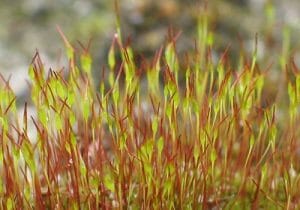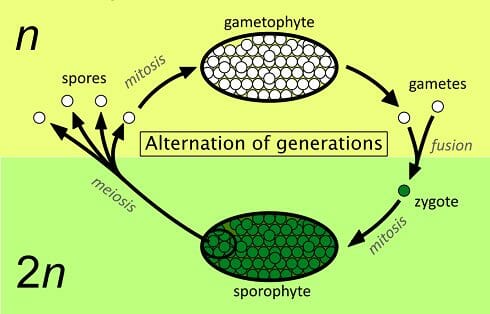Sporophyte Definition
Plants may look simple, but the way they preserve their species is anything but. They have a life cycle which involves alternation between a generation of one set of chromosomes (haploid) and two sets of chromosomes (diploid) in order to reproduce.
While the term sporophyte is referred to as plants that produce spores, the real definition is more complicated and interesting. In a plant’s life cycle, the spore-producing phase is called sporophyte. There are two stages of reproduction in plants: sexual and asexual. Through the process of meiosis and fertilization, the alternation of generation segregates these two phases into the sporophyte and gametophyte.
To clearly understand the plant’s life cycle, sporophyte is the phase when plants produce diploid (2n) spores, which in turn [spores] develop into gametophytes. During the gametophyte stage, haploid (n) gametes or reproductive cells such as sperm and eggs are developed. The eggs are fertilized by sperm and grow into sporophytes.
This image shows a sporophyte of a young moss. You can see the gametophyte as the dominant generation while the sporophytes are composed of stalk growing from the tips of the gametophytes.
Function of Sporophyte
Plants are amazing natural wonders. They have both sperm and eggs, but they can also reproduce tiny versions of themselves through spores. The spores are diploid cells containing genetic information about the plant itself, thus making it capable of asexual reproduction. However, plants are also capable of sexual reproduction by means of the union of a sperm and an egg.
The basic function of the sporophyte is to create spores – that much is known already. The spores, in turn, produce the gametophytes that give rise to the male and female gametes through the process of meiosis. Meiosis is the type of cell division that reduces the number of chromosomes in half. After this process, the reproductive cells are ready to be fertilized to produce the sporophyte, thus completing the cycle.
Without the sporophyte, the life cycle of plants will be disrupted and plants will not be able to reproduce. Without it, fruits won’t develop and plants will merely rely on asexual methods of propagation. This weakens the genetic pool of plant species.
This diagram shows the alternation of generations between the diploid sporophyte and the haploid gametophyte.
Examples of Sporophyte
Sporophytes are referred to as spore-producing plants. However, it is important to take note of the fact that all plants produce spores. Plants that have sporophytes are classified as non-vascular and vascular plants, and are further categorized into different botanical phyla. This section will discuss the classifications of sporophytes.
Non-Vascular Plants
This refers to plants that do not have any vascular system such as xylem and phloem – they are likened to the circulatory system of the human body. Instead, they have simpler tissues that function in the efficient internal transport of water. These plants live in moist environments so that they can have free and constant access to water. Under this plant classification, the sporophyte generation is not dominant and is often smaller and more short-lived than the gametophyte generation. Examples of non-vascular sporophytes are as follows:
1. Bryophytes
Bryophytes are comprised of mosses, liverworts, and hornworts. These plants are primarily haploid gametophytes with a diploid portion attached to the plant consisting of the sporangium and stalk. They do not grow tall because they do not have any water-conducting tissues compared to vascular plants. The male gametes are free-living and need to swim up to the egg for fertilization. Have you ever wondered why there are no tall mosses? Aside from the lack of vascular bundles, it is highly impossible for the sperm to swim up the tree.
2. Algae
Green, red, and brown algae follow alternation of genes from gametophyte to sporophyte generation. In some algae, the sporophytes and gametophytes look the same, but some green and brown algae look different.
Seedless Vascular Plants
Seedless vascular plants have vascular bundles, but they do not produce seeds. Their life cycle alternates between diploid sporophyte and haploid gametophyte phase. The gametophyte stage also requires water for sperm motility during the production of gametes. They are commonly found in moist places. They can undergo asexual reproduction through lightweight haploid spores, an adaptation that allows them to colonize other areas.
1. Horsetail
Also called Equisetum, horsetail is the only extant species of the genus Equisetaceae. Thus, it is considered a living fossil. The spores are produced in the strobili through the process of sporangiogenesis. The sporophyte generation is visible to the naked eye while the gametophyte is microscopic.
2. Ferns
A fern is a group of plants that reproduce by means of spores. There are more than 10,000 living species that belong to this group. Unlike mosses, they have vascular bundles, leaves, and stems. The sporophytes of ferns are usually bigger than the free-living gametophytes. For instance, the sperm is flagellated while the egg is attached to the prothallus. The sperm needs to swim towards the egg for successful fertilization. But how about tree ferns? They have a certain reproductive adaptation. First, the gametophyte develops close to the ground where water can aid in fertilization so the sperm does not need to swim up the tree to fertilize the egg.
3. Club mosses
Club mosses are not real mosses. They are abundant in moist regions. There are only 1,000 living species belonging to this group. Their sporophytes are made up of leafy stems and they do not reach more than 30 centimeters in height.
Vascular Seed-Bearing Plants
Seed-bearing vascular plants have xylem and phloem for nutrient and water transport. They have the natural ability to produce seeds or a fertilized embryo surrounded by nutritive tissue known as seed coat. Seed bearing plants are considered modern plants because they came into existence about 360 million years ago during the carboniferous period.
1. Gymnosperm
Gymnosperms are a group of seed-bearing yet flowerless plants. They include plants like conifers (pine trees), ginkgo, cycads, and gnetophytes. The life cycle of gymnosperm is also characterized with alternation of germination. The life cycle of gymnosperms is characterized by having both sporophytic and gametophytic phases. However, gymnosperms are dominant in the sporophytic phase, while the gametophytic stage is short-lived. Conifers produce two types of spores – microspores and megaspores – that are produced in the pollen cones.
2. Angiosperms
Angiosperms are the most abundant of all types of plants. They are comprised of flowering plants that generate both male and female gametes. Meiosis in this group of plants produce two kinds of spores which include the microspores (male) and megaspores (female). The nucleus of the megaspore undergoes mitosis to produce the egg cells that will start the sporophytic generation: two synergid cells, a large central cell, and three antipodal cells.
In vascular seed-bearing plants, the sporophyte is made of the entire body of the plant except for the embryo sac and pollen.
Related Biology Terms
- Alternation of generation – The fluctuation between the diploid and haploid stages that occurs in the plant life cycle.
- Mitotic sporogenesis – A type of asexual reproduction that is characterized by the production of spores through the process of mitosis.
- Haplodiplontic life cycle – A life cycle of plants that involves the production of diploid sporophyte and haploid gametophytes through the process of meiosis.
Quiz
1. What is a sporophyte?
A. It is the spore-producing phase of plants
B. The phase in the life cycle of plants that produce haploid spores
C. The life cycle exclusive for mosses and ferns
D. Both a and b
E. None of the above
2. Which is the function of sporophyte?
A. It produces gametes during the process of mitosis
B. It produces haploid spores for asexual reproduction
C. It produces new plants
D. It promotes mitosis to produce multicellular spores
3. Which is not an example of a sporophyte?
A. Bryophyte
B. Protista
C. Gymnosperm
D. Angiosperm


